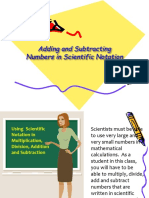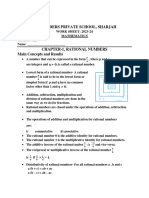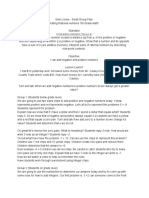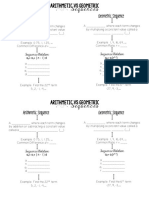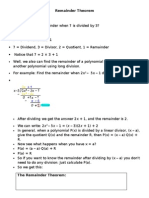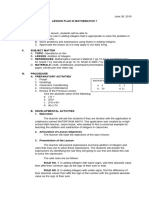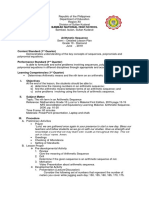0 ratings0% found this document useful (0 votes)
36 viewsLesson 3: Sets and The Venn Diagram
This document discusses key concepts in sets and Venn diagrams including:
1) The union of sets A and B contains all elements that are in A, B, or both.
2) The intersection of sets A and B contains the common elements that are in both A and B.
3) The difference of sets A and B contains elements of A that are not in B.
4) The complement of set A contains all elements of the universal set that are not in A.
It then provides two word problems to demonstrate applying these concepts.
Uploaded by
Anne CarcamoCopyright
© © All Rights Reserved
Available Formats
Download as PPTX, PDF, TXT or read online on Scribd
0 ratings0% found this document useful (0 votes)
36 viewsLesson 3: Sets and The Venn Diagram
This document discusses key concepts in sets and Venn diagrams including:
1) The union of sets A and B contains all elements that are in A, B, or both.
2) The intersection of sets A and B contains the common elements that are in both A and B.
3) The difference of sets A and B contains elements of A that are not in B.
4) The complement of set A contains all elements of the universal set that are not in A.
It then provides two word problems to demonstrate applying these concepts.
Uploaded by
Anne CarcamoCopyright
© © All Rights Reserved
Available Formats
Download as PPTX, PDF, TXT or read online on Scribd
You are on page 1/ 11
Lesson 3:
Sets and the
Venn
Diagram
UNION
of sets A and B, denoted by
A U B, is the set that contains all
the elements in sets A and B as
represented by the shaded part
of the Venn Diagram.
INTERSECTION
Set of A and B, denoted by
A ∩ B, is the set that contains
all the common elements to
sets A and B.
DIFFERENCE
Set of A and B, denoted by
A – B, is the set that contains
all elements in A which are
not in B.
COMPLEMENT
Set of A denoted by A’ , is
the set that contains all
elements in the universal set
that are not in set A.
World Problem
In a group of 50 students, 20
likes Mathematics only. How
many students like English only
if 16 of them like both
Mathematics and English? How
many like English in general?
Problem No. 2
suppose that among the 20 students,
15 students like the sport of
basketball, 8 students like boxing and
2 students didn’t like any of the
sports, how many students like
basketball and boxing?
You might also like
- Quarter 1-Week 2-Lesson 2 Arithmetic Sequences, Means and Series100% (1)Quarter 1-Week 2-Lesson 2 Arithmetic Sequences, Means and Series5 pages
- 3rd Quarter Assessment Task (Take Home Activities)100% (1)3rd Quarter Assessment Task (Take Home Activities)16 pages
- Factoring Special Products Worksheet PDFNo ratings yetFactoring Special Products Worksheet PDF2 pages
- Lesson Plan Rational Numbers DifferentiatedNo ratings yetLesson Plan Rational Numbers Differentiated5 pages
- Math30-1 Diploma Practice Exam PermutationsAndCombinationsNo ratings yetMath30-1 Diploma Practice Exam PermutationsAndCombinations12 pages
- Mutually Exclusive Events, Not Mutually Exclusive Events, Dependent Events and Independent EventsNo ratings yetMutually Exclusive Events, Not Mutually Exclusive Events, Dependent Events and Independent Events26 pages
- Geometric and Arithmetic Sequences NotesNo ratings yetGeometric and Arithmetic Sequences Notes1 page
- Measure of Central Tendency Grouped DataNo ratings yetMeasure of Central Tendency Grouped Data10 pages
- New Mathematics Baseline Test Grade 7 2020No ratings yetNew Mathematics Baseline Test Grade 7 202013 pages
- Mathematics Investigation and Problem Solving Inquiry ProjectNo ratings yetMathematics Investigation and Problem Solving Inquiry Project3 pages
- Lesson Plan Mathematics 9&10: Marcelino Fule Memorial College Alaminos, Laguna S.Y. 2020-2021No ratings yetLesson Plan Mathematics 9&10: Marcelino Fule Memorial College Alaminos, Laguna S.Y. 2020-20217 pages
- Topic - Probability of Dependen Event PPT 2No ratings yetTopic - Probability of Dependen Event PPT 220 pages
- Quarter 1-Week 2-Lesson 2 Arithmetic Sequences, Means and SeriesQuarter 1-Week 2-Lesson 2 Arithmetic Sequences, Means and Series
- 3rd Quarter Assessment Task (Take Home Activities)3rd Quarter Assessment Task (Take Home Activities)
- Math30-1 Diploma Practice Exam PermutationsAndCombinationsMath30-1 Diploma Practice Exam PermutationsAndCombinations
- Mutually Exclusive Events, Not Mutually Exclusive Events, Dependent Events and Independent EventsMutually Exclusive Events, Not Mutually Exclusive Events, Dependent Events and Independent Events
- Mathematics Investigation and Problem Solving Inquiry ProjectMathematics Investigation and Problem Solving Inquiry Project
- Lesson Plan Mathematics 9&10: Marcelino Fule Memorial College Alaminos, Laguna S.Y. 2020-2021Lesson Plan Mathematics 9&10: Marcelino Fule Memorial College Alaminos, Laguna S.Y. 2020-2021


















